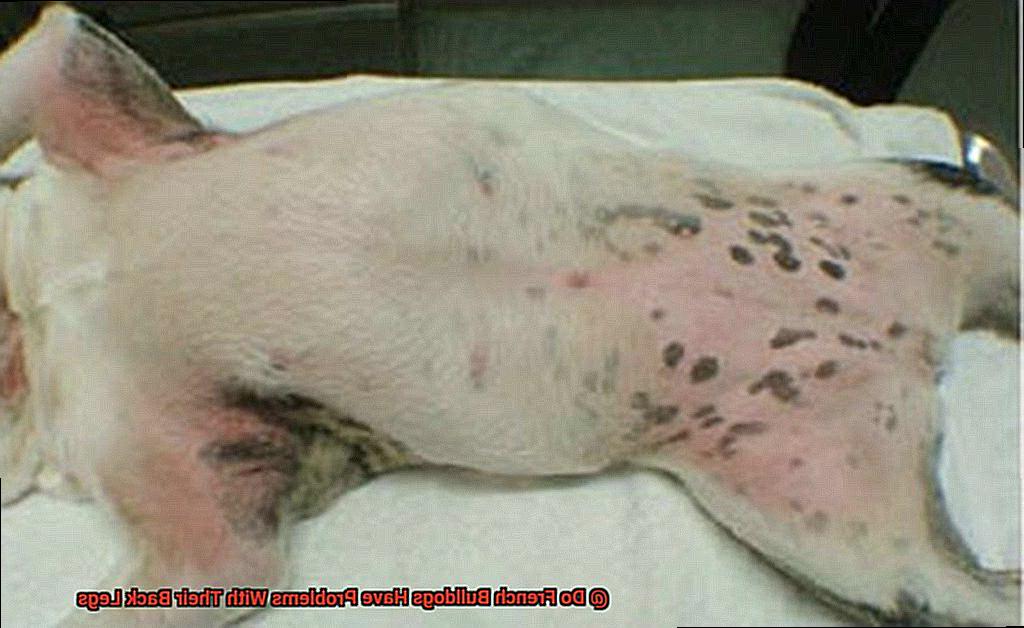Do French Bulldogs Have Problems With Their Back Legs?
Those squishy-faced bundles of joy that have stolen our hearts with their undeniable cuteness and playful personalities. But amidst all the snorts and snuggles, it’s important to address the elephant in the room – do these adorable pups really have problems with their back legs? Well, fear not.
In this blog post, we’re going to dive deep into this hot topic, separating fact from fiction and giving you a clear picture of what potential issues French Bulldogs might face with their hind limbs.
Whether you’re considering bringing home a Frenchie or just curious about canine health, join us on this journey as we uncover the truth behind those wagging tails and wobbly walks.
Do French Bulldogs have problems with their back legs
Contents
- 1 Do French Bulldogs have problems with their back legs
- 2 What Causes Issues in French Bulldog’s Back Legs?
- 3 Patellar Luxation in French Bulldogs
- 4 Hip Dysplasia and French Bulldogs
- 5 Intervertebral Disc Disease (IVDD) in French Bulldogs
- 6 Hemivertebrae and French Bulldogs
- 7 Symptoms of Back Leg Issues in French Bulldogs
- 8 Diagnosis and Treatment of Back Leg Issues in French Bulldogs
- 9 Prevention of Back Leg Problems in French Bulldogs
- 10 Conclusion
French Bulldogs are beloved companions known for their distinctive appearance and friendly nature. However, like any breed, French Bulldogs can experience health issues, including problems with their back legs. In this article, we’ll explore common back leg problems that French Bulldogs may encounter and provide tips on prevention and management.
Patellar Luxation:
Patellar luxation occurs when the kneecap slips out of its normal position. Signs of this condition include limping, difficulty walking, and a clicking sound when the dog moves. While patellar luxation can affect any breed, it is more frequently seen in small to medium-sized dogs like French Bulldogs. In severe cases, surgery may be necessary to correct the problem.
Hip Dysplasia:
Hip dysplasia is a hereditary condition where the hip joint doesn’t develop properly. This leads to pain, lameness, and difficulty rising or walking. Although more common in larger breeds, French Bulldogs are not immune to hip dysplasia. Responsible breeders often perform hip evaluations on their breeding dogs to reduce the risk of passing on this condition.
Intervertebral Disc Disease (IVDD):
IVDD affects the spinal discs, causing degeneration or herniation that puts pressure on the spinal cord. Symptoms of IVDD may include reluctance to move, dragging of the back legs, or an abnormal gait. This condition can range from mild discomfort to severe paralysis. Proper exercise, avoiding high-impact activities, and regular veterinary check-ups are crucial for early detection and management.
Hemivertebrae:
Hemivertebrae is a condition where one or more vertebrae in the spine are deformed, leading to an abnormal curvature. This can cause back pain, difficulty walking, and potentially paralysis in severe cases. Regular veterinary monitoring and awareness of posture and movement are essential to identify and manage this condition.
Prevention and Management:
To minimize the risk of back leg problems in French Bulldogs, consider the following:
- Maintain a healthy weight through a balanced diet and regular exercise to reduce strain on joints.
- Use orthopedic bedding and provide non-slip surfaces to support your dog’s comfort.
- Avoid activities that put excessive strain on the back, such as jumping from heights or excessive running.
- Schedule regular veterinary check-ups to monitor your French Bulldog’s overall health and detect any issues early on.
- Consider supplementing with joint-supporting supplements, under veterinary guidance, to promote joint health.
What Causes Issues in French Bulldog’s Back Legs?
It’s true. In this blog post, we’ll dive into the causes of these problems so that you can be informed and proactive in keeping your furry friend happy and healthy.
Patellar Luxation:
Imagine this – your Frenchie is happily trotting along when suddenly, their kneecap slides out of place. Ouch. This condition, called patellar luxation, is a common cause of back leg issues in French Bulldogs. It can be genetic or the result of trauma or injury.
Intervertebral Disc Disease (IVDD):
The discs between the vertebrae in your Frenchie’s spine can degenerate or become herniated, leading to IVDD. This painful condition affects their mobility and often manifests as weakness or paralysis in the back legs.
Hip Dysplasia:
Hip dysplasia is another concern for French Bulldogs. It occurs when the hip joints don’t develop properly, leading to instability and eventually arthritis. Genetics and environmental factors like excessive growth or weight gain can play a role in its development.
Swimmer Puppy Syndrome:
Now, this one is rather unique to Frenchies. Swimmer puppy syndrome affects their ability to walk and stand properly, often due to poor muscle tone and development. Genetic and environmental factors come into play here.
Other Potential Causes:
Let’s not forget about other potential culprits. Spinal cord compression, muscle or ligament injuries, and nerve damage can also contribute to back leg issues in French Bulldogs.
Patellar Luxation in French Bulldogs
Today, we’re going to dive into the world of patellar luxation and how it affects our beloved furry friends. Patellar luxation is a common orthopedic condition that can cause discomfort and mobility issues for French Bulldogs. But fear not. We’re here to shed some light on this topic and provide you with valuable insights to help you navigate this journey with your pup.
What is Patellar Luxation?
Patellar luxation occurs when the kneecap (patella) slips out of its normal position within the groove of the femur bone. This can range from mild cases where the patella can be manually manipulated back into place, to severe cases that may require surgery for correction.
Causes of Patellar Luxation:
Patellar luxation in French Bulldogs can be congenital (present at birth) or develop later in life due to trauma or degenerative changes in the knee joint. Our adorable Frenchie friends are more prone to this condition due to their unique body structure, with their short stature and compact build. Other factors that can contribute to patellar luxation include obesity, lack of muscle tone, and improper nutrition.
Signs and Symptoms:
So, how do you know if your French Bulldog is dealing with patellar luxation? Keep an eye out for signs such as limping, skipping or hopping on one leg, and an abnormal gait. If you notice any of these symptoms, it’s time to pay a visit to your veterinarian for a proper diagnosis.
Treatment Options:
The treatment for patellar luxation depends on the severity of the condition. In mild cases, conservative management such as weight management and physical therapy may be sufficient. Regular exercise and maintaining a healthy body weight can also help prevent the development or progression of patellar luxation.
However, in more severe cases, surgical intervention may be necessary to correct the displacement and prevent further complications.
Hip Dysplasia and French Bulldogs
In this blog post, we will explore the causes, symptoms, diagnosis, and treatment options for hip dysplasia in French Bulldogs.
Causes:
Hip dysplasia in French Bulldogs is primarily caused by a combination of genetic and environmental factors. Genetics play a significant role, so it is essential to choose breeding dogs with good hip scores to reduce the risk of passing on the condition. Environmental factors such as rapid growth, excessive weight gain, improper nutrition, and overexercise can also contribute to the development of hip dysplasia.
Symptoms:
The symptoms of hip dysplasia in French Bulldogs can vary from mild to severe. Look out for signs such as pain, stiffness, difficulty in getting up or climbing stairs, bunny hop-like gait, or reluctance to engage in physical activities. If you notice any of these symptoms, it’s crucial to consult a veterinarian for a proper diagnosis.
Diagnosis:
Diagnosing hip dysplasia in French Bulldogs involves a thorough physical examination and diagnostic imaging techniques like X-rays. During the examination, your veterinarian will assess the dog’s range of motion, stability, and pain response in the hips. X-rays provide detailed images of the hip joint structure and help determine the severity of the condition.
Treatment:
The treatment options for hip dysplasia in French Bulldogs depend on the severity of the condition. Non-surgical approaches include weight management, exercise modification, physical therapy, and medication to manage pain and improve mobility. These measures can slow down the progression of the disease and provide relief.
In more severe cases or when conservative treatments fail, surgical intervention may be necessary. Surgical options like femoral head ostectomy (FHO), total hip replacement (THR), and pelvic osteotomy aim to restore stability and improve the function of the hip joint.
Prevention:
Prevention is crucial in managing hip dysplasia in French Bulldogs. Breeders should prioritize selecting breeding dogs with good hip scores and no history of hip dysplasia. Regular exercise, proper nutrition, and weight management are also essential factors in preventing the development or progression of this condition.
Hip dysplasia can affect French Bulldogs, causing pain and mobility issues. However, with early detection, appropriate treatment, and preventive measures, the impact of hip dysplasia on a French Bulldog’s quality of life can be minimized.
As a responsible owner, it is essential to be aware of the causes, symptoms, and treatment options available to ensure the well-being and overall health of your furry friend.
Intervertebral Disc Disease (IVDD) in French Bulldogs
French Bulldogs are known for their adorable appearance and playful personalities, but did you know that they are prone to a common spinal condition called Intervertebral Disc Disease (IVDD)? This condition can cause significant problems with their back legs, making it important for owners to be aware of the signs, take preventive measures, and seek prompt veterinary care if necessary.
Why Are French Bulldogs Susceptible to IVDD?
French Bulldogs have a compact and muscular build, with a broad chest and short, stout limbs. While these characteristics contribute to their charm, they also put them at a higher risk for spinal issues. The discs between the vertebrae of their spine can deteriorate or become damaged, causing them to bulge or herniate. This can lead to compression of the spinal cord or nerves, resulting in pain, weakness, and loss of coordination in the hind legs.
Signs of IVDD in French Bulldogs
The symptoms of IVDD can vary depending on the severity of the condition. Mild cases may present as stiffness or difficulty in getting up and down, while more severe cases can lead to paralysis in the hind legs. Other signs may include reluctance to jump, yelping or crying when touched on the back or neck, and changes in bladder or bowel control. If you notice any of these signs, it is crucial to seek veterinary care immediately.
Seeking Veterinary Care and Treatment Options
When you suspect that your French Bulldog may be suffering from IVDD, it is essential to consult with a veterinarian. They will perform a thorough physical examination and may recommend diagnostic tests such as X-rays or an MRI to confirm the diagnosis. Treatment options for IVDD range from conservative management to surgical intervention. In less severe cases, rest, pain medication, and physical therapy may be recommended to help alleviate symptoms and promote healing. However, if the condition is more advanced or if there is evidence of spinal cord compression, surgery may be necessary to relieve pressure and restore function.
Prevention is Key
Prevention plays a vital role in managing IVDD in French Bulldogs. Here are some measures you can take to minimize the risk:
- Maintain a healthy weight: Obesity puts additional strain on the spine, so ensure your French Bulldog maintains a balanced diet and gets regular exercise.
- Avoid high-impact activities: Jumping from heights or engaging in rough play can increase the risk of spinal injuries. Encourage low-impact exercises and supervised playtime.
- Create a supportive environment: Provide orthopedic beds or ramps for easier access to furniture. This helps minimize stress on the spine and reduces the chances of injuries.
Hemivertebrae and French Bulldogs
In this blog post, we will explore the causes and impacts of hemivertebrae in French Bulldogs, and provide insights on how to manage and prevent this condition to ensure the best quality of life for your furry friend.
What is Hemivertebrae?
- Hemivertebrae is a congenital deformity of the spine where one or more vertebrae are malformed.
- This abnormality can put pressure on the spinal cord and nerves, leading to neurological problems.
Why are French Bulldogs Predisposed to Hemivertebrae?
- French Bulldogs have a unique body structure with short, stocky bodies and a screw tail, which increases their likelihood of developing hemivertebrae.
- The genetic mutation that causes the screw tail also affects the development of the spine.
Symptoms of Hemivertebrae in French Bulldogs:
- Difficulty walking or standing
- Abnormal gait
- Dragging of the hind legs
- Pain or discomfort
- Paralysis in severe cases
Seeking Veterinary Attention:
- If you suspect your French Bulldog has hemivertebrae or is experiencing back leg issues, it’s important to seek veterinary attention.
- A thorough examination and diagnostic tests such as X-rays or an MRI may be recommended to confirm the presence of hemivertebrae.
Treatment Options:
- Conservative management: Physical therapy exercises to strengthen muscles supporting the spine and improve mobility, along with pain management medications.
- Surgical intervention: Stabilizing the spine and restoring normal function to the back legs in severe cases.
Prevention:
- Responsible breeding practices: Breeders should perform thorough health screenings and avoid breeding dogs with known spinal abnormalities.
- Regular veterinary check-ups and maintaining a healthy weight can help reduce the risk of developing back leg problems associated with hemivertebrae.
Symptoms of Back Leg Issues in French Bulldogs
French Bulldogs are lovable, adorable creatures that bring joy to our lives. However, their unique body structure and genetic predispositions make them prone to certain back leg issues.
It’s important for owners to be aware of the symptoms of these issues so they can provide appropriate care and treatment. Let’s dive into the world of French Bulldog back leg issues and explore the signs to look out for.
Difficulty Walking or Limping
One telltale sign that your French Bulldog may be experiencing back leg issues is difficulty walking or a noticeable limp. This can be caused by conditions such as hip dysplasia, patellar luxation, or intervertebral disc disease. If you notice your furry friend struggling to move around or favoring one leg, it’s time to consult with a veterinarian.
Reluctance to Climb Stairs or Jump
Does your French Bulldog suddenly hesitate to climb stairs or jump onto furniture? This could be a sign of pain or discomfort in the back legs. Many back leg issues can make these activities difficult and uncomfortable for your pup. If you notice a sudden change in their behavior when it comes to stairs or jumping, it’s worth investigating further.
Change in Posture or Gait
Keep an eye out for any changes in your French Bulldog’s posture or gait. Back leg issues can cause a hunched or arched back, and the hind legs may appear stiff or weak. Your furry friend may also have difficulty maintaining a normal gait, which can be a result of pain or muscle weakness.
Muscle Atrophy
Muscle atrophy is another symptom that can indicate back leg issues in French Bulldogs. If you notice that the muscles in your pup’s hind legs have become visibly smaller or less developed, it could be a sign that they are experiencing muscle weakness or nerve damage.
Difficulty Standing Up or Maintaining Balance
French Bulldogs with back leg issues may struggle to stand up from a lying position or have trouble maintaining their balance while standing. This can be particularly noticeable when they are trying to get up after a nap or when they are standing for an extended period of time. If you notice your furry friend struggling with these activities, it’s important to seek veterinary attention.
Paralysis
In severe cases, back leg issues can lead to paralysis in French Bulldogs. This means that your pup may become completely unable to use their hind legs. If you notice any signs of paralysis, it’s crucial to seek immediate veterinary care.
Remember, these symptoms can vary depending on the specific condition affecting your French Bulldog’s back legs. It’s always best to consult with a veterinarian for an accurate diagnosis and appropriate treatment plan.
Diagnosis and Treatment of Back Leg Issues in French Bulldogs
French Bulldogs are a delightful breed known for their affectionate nature and captivating appearance. However, they are also prone to back leg issues that can hinder their mobility and overall quality of life. In this expert-level overview, we will delve into the diagnosis and treatment of common back leg issues in French Bulldogs, offering insights and advice to help you support your furry friend.
Common Back Leg Issues:
Hip Dysplasia:
Hip dysplasia is a condition where the hip joint is improperly formed, leading to instability and discomfort. Diagnosis involves X-rays and physical examinations to assess the hip joint’s structure and range of motion. Treatment options for hip dysplasia may include:
- Weight management: Maintaining a healthy weight helps reduce stress on the joints.
- Physical therapy: Exercises tailored to strengthen muscles surrounding the hip joint can provide stability.
- Medication: Non-steroidal anti-inflammatory drugs (NSAIDs) may be prescribed to alleviate pain and inflammation.
- Surgery: In severe cases, surgical interventions like total hip replacement or femoral head ostectomy may be considered.

Patellar Luxation:
Patellar luxation occurs when the kneecap slips out of its normal position. Physical examinations and X-rays are used to diagnose this condition. Treatment options may include:
- Conservative management: Restricting exercise levels, using pain medication, and providing joint supplements can help manage mild cases.
- Surgical correction: Severe or persistent cases may require surgery to realign the patella and stabilize the knee joint.
Intervertebral Disc Disease:
Intervertebral disc disease refers to degeneration or herniation of the discs in the spine. Diagnosis involves physical examinations, X-rays, or advanced imaging techniques like MRI. Treatment options may include:
- Rest: Limiting physical activity can help alleviate pain and reduce further damage.
- Medication: Pain medication and anti-inflammatory drugs may be prescribed to manage symptoms.
- Physical therapy: Targeted exercises and therapies can aid in recovery and strengthen the supporting muscles.
- Surgery: In severe cases, surgical intervention may be necessary to alleviate pressure on the spinal cord.
Prevention and Overall Care:
While back leg issues can be a concern for French Bulldogs, there are preventive measures you can take to minimize the risk:
- Balanced diet: Providing a nutritious and balanced diet helps maintain a healthy weight, reducing strain on the joints.
- Exercise moderation: Avoid excessive jumping or rough play that may put stress on the back legs.
- Regular exercise: Gentle and regular exercise, such as walking or swimming, helps keep muscles strong and joints flexible.
- Supportive devices: Consider using ramps or stairs to minimize strain when accessing elevated surfaces.
- Veterinary check-ups: Regular visits to your veterinarian ensure early detection of any potential issues and facilitate appropriate treatment.
Prevention of Back Leg Problems in French Bulldogs
French Bulldogs are adorable and lovable pets, but they are prone to certain back leg problems that can affect their mobility and quality of life. As a responsible pet owner, it is important to take proactive measures to prevent these issues. In this guide, we will explore key strategies that can help keep your French Bulldog’s back legs healthy and strong.
Responsible Breeding:
Choosing a reputable breeder is the first step in preventing back leg problems in French Bulldogs. Look for breeders who conduct health screenings on their breeding dogs, particularly for conditions like hip dysplasia and luxating patella. By selecting a puppy from parents with good hip and knee health, you reduce the risk of your dog inheriting these genetic predispositions.
Proper Nutrition:
Maintaining a healthy weight is essential for preventing back leg problems in French Bulldogs. Obesity puts extra strain on their joints, increasing the chances of developing conditions like hip dysplasia or arthritis. Consult with your veterinarian to determine the appropriate diet and portion sizes for your Frenchie, ensuring they receive the necessary nutrients without excess calories.
Regular Exercise:
Regular exercise is crucial for keeping your French Bulldog’s back legs strong and healthy. Engage in low-impact activities that don’t put excessive stress on their joints, such as leash walks, swimming, or controlled play sessions. Avoid high-impact activities like jumping or intense running, as these can exacerbate existing leg issues.
Regular Veterinary Check-ups:
Schedule regular veterinary check-ups to monitor your French Bulldog’s overall health and detect any early signs of back leg problems. Your veterinarian can perform orthopedic exams to assess joint health and recommend preventive measures or treatments if necessary. Early intervention is key to managing and preventing further progression of these issues.
Environmental Modifications:
Make environmental modifications to support your French Bulldog’s leg health. Provide comfortable bedding with good support to alleviate pressure on their joints during rest. Invest in ramps or stairs to help them navigate furniture and avoid jumping, which can lead to injuries or worsen existing leg conditions.
Be Aware of Signs and Symptoms:
Stay vigilant and be aware of signs and symptoms that indicate potential back leg problems in your French Bulldog. Look out for limping, difficulty walking or running, reluctance to climb stairs or jump, and changes in gait. If you notice any of these signs, consult with your veterinarian promptly for proper diagnosis and treatment.
Conclusion
French Bulldogs are known for their adorable appearance and playful personalities. However, it’s important to address the potential problems they may face with their back legs. These lovable pooches can be prone to issues such as hip dysplasia, patellar luxation, and intervertebral disc disease. These conditions can cause discomfort, pain, and difficulty in mobility for our furry friends.
Hip dysplasia is a condition where the hip joint doesn’t develop properly, leading to instability and inflammation. This can result in limping, stiffness, and even arthritis over time. Patellar luxation occurs when the kneecap slips out of place, causing intermittent lameness and difficulty in walking. Intervertebral disc disease affects the spinal discs, leading to pain, weakness in the hind legs, and potential paralysis if left untreated.
It’s essential for French Bulldog owners to be aware of these potential issues and take proactive measures to prevent or manage them. Regular exercise that is low-impact and gentle on their joints can help maintain muscle tone while reducing strain on their back legs. A balanced diet with appropriate nutrients can also support their overall bone health.
Additionally, regular visits to the veterinarian are crucial for early detection and treatment of any potential problems. Your vet may recommend X-rays or other diagnostic tests to assess your French Bulldog’s joint health and identify any underlying issues.
In conclusion, while French Bulldogs may have a predisposition to back leg problems, proper care and attention can go a long way in ensuring their well-being.




